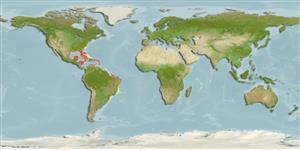Neofibularia nolitangere (Duchassaing & Michelotti, 1864)
Touch-me-not sponge| Native range | All suitable habitat | Point map | Year 2050 |

|
| This map was computer-generated and has not yet been reviewed. |
| Neofibularia nolitangere AquaMaps Data sources: GBIF OBIS |
Upload your photos
Google image |
No photo available for this species.No drawings available for Desmacellidae.
Google image |
No photo available for this species.
Classification / Names Common names | Synonyms | CoL | ITIS | WoRMS
Demospongiae | Poecilosclerida | Desmacellidae
Environment: milieu / climate zone / depth range / distribution range Ecology
Sessile; depth range 2 - 70 m (Ref. 108813). Tropical
Distribution Countries | FAO areas | Ecosystems | Occurrences | Introductions
Western Central Atlantic.
Length at first maturity / Size / Weight / Age
Maturity: Lm ? range ? - ? cm Max length : 80.0 cm WD male/unsexed; (Ref. 415)
Short description Morphology
Thick encrusting: 0.4 - 3 cm, or massive to large vases: up to 80 cm wide and high. Brown-red in color externally, tan internally. Surface varies from smooth and porous, to corrugated and micro hispid, somewhat velvety. Oscules dispersed: 0.3 - 0.6 cm wide. Firm but fragile (Ref. 415).
Maximum depth reported taken from Ref. 128739. On reef environments, usually under 5 m deep (Ref. 415). Also found in mangroves (Ref. 86836). Dwells in coral reefs or rock pavements in shallow depths. Possibly associated with polychaete worms (Ref. 128739).
Life cycle and mating behavior Maturity | Reproduction | Spawning | Eggs | Fecundity | Larvae
Members of the class Demospongiae are hermaphroditic. Life cycle: The zygote develops into parenchymella larva (free-swimming) before settling down on a substrate where it grows into a young sponge.
Main reference
References | Coordinator | Collaborators
Collin, R., M.C. Díaz, J. Norenburg, R.M. Rocha, J.A. Sánchez, M. Schulze, A. Schwartz and A. Valdés. 2005. (Ref. 415)
IUCN Red List Status
(Ref. 130435: Version 2024-2)
CITES status (Ref. 108899)
Not Evaluated
CMS (Ref. 116361)
Not Evaluated
Threat to humans
Human uses
| FishSource |
Tools
More information
Trophic Ecology
Food items
Diet composition
Food consumption
Food rations
Predators
Diet composition
Food consumption
Food rations
Predators
Ecology
Population dynamics
Growth
Max. ages / sizes
Length-weight rel.
Length-length rel.
Length-frequencies
Mass conversion
Recruitment
Abundance
Max. ages / sizes
Length-weight rel.
Length-length rel.
Length-frequencies
Mass conversion
Recruitment
Abundance
Life cycle
Distribution
Human Related
Aquaculture profiles
Stamps, coins, misc.
Stamps, coins, misc.
Outreach
References
Internet sources
BHL | BOLD Systems | CISTI | DiscoverLife | FAO(Publication : search) | Fishipedia | GenBank (genome, nucleotide) | GloBI | Gomexsi | Google Books | Google Scholar | Google | PubMed | Tree of Life | Wikipedia (Go, Search) | Zoological Record
Estimates based on models
Preferred temperature
(Ref. 115969): 23.6 - 28, mean 27 (based on 210 cells).
Price category
(Ref. 80766):
Unknown.


